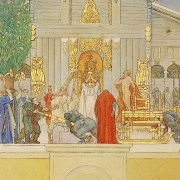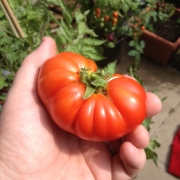Holy Odinic Symbols: The Fylfot/Swastika
History
The Fylfot was a most sacred symbol to our Odinist forefathers of the Germanic lands, and to all the pre-Christian peoples of Europe. Archaeological evidence of Fylfot-shaped ornaments has been found to date from the Neolithic period, which proves it pedigree indeed and in no uncertain terms. In England, artefacts displaying Fylfot carvings of a very varied nature have been found in several different regions, from cremation urns in East Anglia, to hilts and sword belts found in Kent.
Etymology
Although exploring the root of words in our langauge is both worthy and interesting, it is also important to remember that just as the term ‘Odinism’ can never hope to convey all that is meant by it, so the epithet of swastika/fylfot alone will never reveal the whole power of this most holy of symbols. As Brian Bates’ character Wulf, an Anglo-Saxon shaman in The Way of Wyrd exclaims,
“Do not live your life searching around for answers in your word-hoard. You will find only words to rationalise your experience. Allow yourself to open up to wyrd and it will cleanse, renew, change and develop your casket of reason. Your word-hoard should serve your experience, not the reverse.”
M. Eugèue Burnouf says of the ‘Swastika’:
“The sign Swastika must have existed long before the name was given to it. It must have been in existence long before the Buddhist religion of the Sanskrit language.
In Great Britain the common name given to the Swastika from Anglo-Saxon times by those who apparently had no knowledge whence it came, or that it came from any other than their own country was Fylfot, said to have been derived from the Anglo-Saxon fower fot, meaning four-footed, or many-footed.”
George Waring , in his work entitled “Ceramic Art in Remote Ages”(p.10), says:
“The word [Fylfot] is Scandinavian and is compounded of Old Norse fiël, equivalent to the Anglo-Saxon fela, German viel, many, and fotr, foot, the many-footed figure.”
Two other names which are commonly used in referring to the Fylfot are hakenkreuz/hooked cross and fire-whisk.
What the Fylfot means
In my research, it became clear to me that the most common meaning of the Fylfot was of cycles, the natural cycles in the cosmos, both vast and minuscule, and everything in between. This idea is compounded with suggestions that the four arms each represent a key point in such cycles, for example: the high festivals (winter solstice, spring equinox, summer solstice and autumnal equinox), the seasons (winter, spring, summer and autumn), the phases of life (birth, life, death and re-birth), the phases of the day (night, morning, day and evening), the elements (air, fire, water and earth), the phases of the Moon (lunar eclipse, waxing, full and waning, the cardinal points (North, East, South, West), etc.
“The wheel is the warming fire of the Sun, that can also burn us; it’s the life-giving water, that can also drown us. It creates life, but also takes life away.” – Varg Vikernes of Burzum
For many, the Fylfot is a symbol of the cosmos revolving around the universal axis, Yggdrasil, which is a constant, eternal ‘pillar’ to the ever-evolving life and ever-ascending spirits of the realms it supports, which are represented by the rotating arms. The purpose of these cycles, the cyclical existence of all things, is, for us at least, to offer us the chance to better ourselves by overcoming struggle and living honourably, so that after each successfully-lived cycle, our spirit becomes purer, allowing us to ascend to a higher realm of existence. In this manner and after an indefinite number of cycles, we eventually hope to reach Asgard.
To me personally, in addition to all of the above, the Fylfot is a beacon of hope, a sign of an unknown greater power that we will never fully comprehend until we have achieved Odin Consciousness, and reached the peak of our spiritual evolution in Asgard. It is a symbol of divine guardianship, a gift from our deities in which we can trust to safety when we use it to conduct the protection rituals before Blot. The Fylfot glows with purity, and smashes malevolence. It teaches victory through perseverance, imparting to us its whirling energies when we invoke its name and visualise its form and power. It is an eternal symbol and it is one of the keys to our evolution and understanding of the Multiverse. This is what the Fylfot is to me.
The Fylfot is also believed to be strongly linked to Thor – indeed, many hold that Miolnir and the Fylfot are one and the same, in that they both serve to protect our Folk from harmful spirits. This makes sense in that historically it was the God of Thunder’s tendency to be among the Deities closest to our Folk – he was the patron and protector of the peasants of course. It has also been discovered that symbols similar to the Fylfot were engraved on the beams of houses to ward them from lightning, which would further support such a link with Thor. Additionally, according to this source:
“The Anglo-Saxons also carved the swastika upon their weapons… It could be that the Anglo-Saxons believed that carving the swastika upon their weapons gave it the power and strength of Thunor, or maybe the warrior carrying the weapon was blessed with Thunor’s protection during battle.”
An interesting musing that I came upon in my readings on the Germanic Preservationist forum, Skadi.com, explained that one can locate the Fylfot in the night sky:
“…as the Odin’s/Thor’s Wagon (Big Dipper) making it turns, and there are others smaller and bigger too.”
As someone who is as yet quite unlearned in this field, I can only read this comment and wonder what constellations these “…others, smaller and bigger…” might be referring to. It is something that I would one day definitely like to investigate.
The possible differences between clockwise and anti-clockwise motion
It is said by some that a clockwise spinning Fylfot (using this orientation 卐) symbolises decomposition, death, destruction i.e. the destructive element to Thor’s Hammer, while an anti-clockwise motion signifies creation, evolution, and the fertility-giving properties of Thor’s Hammer. An interesting train of thought that I have come upon conducive to the above statement is that when rotating anti-clockwise, the creative sun-wheel could be said to be conducting powers into our world from the higher realms. Yet when spinning clockwise, the role is reversed and the destructive power of Miolnir is returning energy from Midgard back to Asgard. Still, I would imagine such suppositions are down to the interpretation and reflection of the individual, as in our present existence we are unable to fully comprehend all the meanings of this most holy of symbols.
How we use the Fyflot today
In addition to the exoteric use of the Fylfot in art, jewellry, woodwork, etc, the Fire-Whisk has some important other functions in our lives. It is used in name and form during the protection rituals at the beginning of each Blot or ritual, whereby the Gothi/Gythia signs the Fylfot at the four cardinal points and above and below, while saying “Fylfot helga ve theta ok hindra alle ilska”, which I believe is roughly translated from Icelandic as “Fylfot, protect this holy ve, and keep out all that would do harm.”. A Fylfot may also often be found to be carved on the hammer used during the Blot.
Another important usage is in the Cone of Power/Swastika Rising ritual, in which I have only participated in personally twice, so my understanding here may be limited. According to Heimgest DCG, the purpose of the ritual is “…to raise regenerative energy, to draw it into yourself and also to send it out across the land and into the ether.” The ritual, taken from the Odinic Rite, is as follows:
All those present form a circle around the fire with their left hand on the shoulder of the person to their left. Right arms are outstretched, starting quite low down, channelling energy to the centre. We visualise the swastika within the flame, will it to strengthen and rise, see it slowly rotate. Now begin the Gealdor of Sig Tiwaz, beginning slowly and quietly at first, building up gradually in tempo and volume. As the Gealdor rises the arms slowly rise, still focusing on a central point. As the chant gets louder and faster the spinning Fylfot is gaining speed and right arms are raised higher and higher as the Gealdor reaches a peak, until the call is being shouted by those gathered. At the final and climatic invocation the spinning Fire-Whisk is forcefully released and sent soaring up into the sky and across all the Odal lands, the power emanating from the location of the Blot fire like water from a fountain.
It is only the author’s limited experience which confines this section to but two examples of the modern use of the Fylfot – no doubt there are others known by more knowledgeable practitioners, and may in time find mention here.
The Fyflot and the Third Reich
We are all of course aware of the political usage of this ancient and holy symbol, and obviously we must decry all efforts to associate any of our holy symbols with a political belief system/party. This we all know and accept as obvious (well, at least those who have any serious desire to preserve our Folk and traditions). Yet, as neutral and honest observers, we can see that, before the Fylfot/Hakenkreuz had become tainted by the activities of the NSDAP, the power it had in the hearts of the Germans as the party rose to power and led Germany, was overwhelming. It had/has a primal draw, deep within our Folk Memory, and it was quite possibly for this reason that the leaders of the Third Reich chose it for their party. They knew something of its primal power, the divine energy that it sparked in the spirits of the people, and they abused this powerful Folk Memory to serve their own ends. So we must wholeheartedly stand against the prostitution of our holy symbols at the hands of politicians; they transcend the mundane and are above such use.
The Eternal Symbol
We can conclude this study by asserting most confidently that the Fylfot is indeed a very powerful symbol, due to its ineffability and myriad meanings: time; the sun; Thor and Miolnir; creation/destruction; the never ending cycle of life, and finally for our striving for the High Realm of Asgard. The Fyflot is the energy within us that we call upon to break down towering barriers (within and without us), to climb the insurmountable, conquer new horizons and to reach out for the stars. It represents the Truth, which most of our Folk cannot even begin to grasp, or even care to try; and yet it is what we here in the OR have set out on the long path to understanding. We may hope only to achieve a brief glimpse of this reality in one lifetime, yet with perseverance, dedicated commitment, and the striving to uphold Odinic virtues, we will reach it in the end.
A post-note on personal study/scrutiny – I believe that study and personal scrutiny of our mythology, folklore and of course symbolism is not only something that should be accepted, but actively encouraged amongst ourselves. For ours is not a ‘dogmatic’ religion, it is organic, constantly growing and evolving, as our very Folk Spirit grows and evolve – nothing is written in the proverbial stone. As our knowledge and comprehension of the world around changes, so our perceptions and understanding of mythology, folklore and symbolism gradually changes to reflect this new scientific knowledge. Having said this however, we are increasingly seeing modern science reflect the deep inner/primal truths reflected in our grand mythology, showing that the wisdom contained therein could hold far more than we in the scientific 21st Century yet grasp. How the ancients obtained such wisdom we will perhaps never know. Yet we look to the present generation to seek an understanding of such things, and as I said above, we must therefore encourage our Folk to re-read and interpret for themselves the lore of our land. We are of the same blood as our ancestors, and those great mythologists Viktor Ryberg and the Circle of Ostara prove that we still have the spirit to delve deeper and re-forge the wisdom of our kind.
Sources, acknowledgements and inspirations
1. The Odinic Rite
2. Blots attended with Fylfot Hearth, Sunna Rising Hearth and Draupnir Hearth
3. The Swastika Rising Ritual by Hemigest DCG, available from the OR in pdf format on request.
4. The Circle of Ostara
5. The Way of Wyrd, Brian Bates.
6. Varg Vikernes of Burzum
7. The author of http://englishheathenism.homestead.com
8. Various members of Skadi Germanic Preservation Forum






Once again, an excellent article Sam!
If you agree I will translate it into French for the Edelweiss Hama website.
FFF
Seb AOR
Thank you Seb – by all means translate it for your website, I’d be honoured mate!
Sam FFF
Great studies and a great read… Thankyou for sharing this
That was a good read! I enjoyed the quote from Varg, also. I enjoy his writings alot. All in all, this was very well written
Very informative,good insight.Thank you for your time and effort.
What does it mean? that comment is awaiting moderation?
It means that someone needs to approve your comment before it appears on the site. It is to prevent spam.
I’ve read this article earlier, but didn’t post until now. The fylfot is a symbol that will protect the good against evil. It’s probably the most powerful symbol on earth for this purpose. And isn’t it interesting that WW2 caused this divine symbol to be banished from the world… I can tell you much more about this than there is space for, I’ve received information from God about it… There are some people out there who run in fear from the Fylfot/Sowelo because it possesses the possibility for physical destruction, ah, but only at the benefit of one’s soul. Of course that would be a bad thing for someone who doesn’t possess a soul… Let us look upon the Fylfot as if it hasn’t ever been used incorrectly. If you are with the Highest God, then this is your symbol.